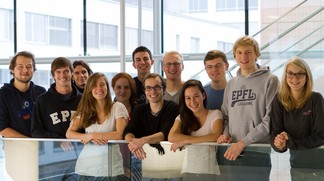Nov 29 2014
The team from EPFL participating in the 2014 iGEM completion has been awarded a gold medal for their innovative Biopad design.
 © 2014 EPFL/Bruno Liardon, Fac. SV
© 2014 EPFL/Bruno Liardon, Fac. SV
The iGEM jamboree is an annual competition on innovative projects in synthetic biology. Participating teams come from universities all over the world. This year, the EPFL iGEM team competed with an idea for an innovative touchscreen device based on touch-responsive bacteria. The device is aptly named “Biopad”, and left its mark at Boston where the competition was held.
The EPFL team, comprised of 13 students (from the BA-MA teaching sections in Life Sciences & Technology and in Computer Science), combined protein complementation techniques with biosensors and microfluidics to achieve fast spatiotemporal analysis of bacterial or yeast responses to stimuli. In short, the team fused complementary reporter protein fragments to interacting proteins. The resulting protein complexes then interact under the presence of a given stimulus, which allowing the fused proteins to re-acquire their functional 3D structure conformation, resulting in the emission of a detectable signal.
To create light signals, the team worked with luciferase enzymes from the firefly and the sea pansy (Renilla reniformis), infrared fluorescent proteins, and a mutant form of green fluorescent protein known as “superfolder GFP”, which can fold and mature rapidly, emitting a bright green signal. The organisms they explored were E. coli and S. cerevisiae.
On the basis of this achievement, the EPFL iGEM team came up with the concept of the Biopad, which they describe as “a biological trackpad made of a microfluidic chip, touch-responsive organisms and a signal detector.” The team envisions applications such as faster and more accurate antibiotic screening and tumor sensing and evaluation.
Aside from the iGEM gold medal, the Biopad drew praise from the maker of the touchscreen Bent Stumpe and the director of CERN, Rolf Heuer.
Author: Nik Papaeorgiou, MediaCom & SV-DO
Source: IC - Prix et récompenses